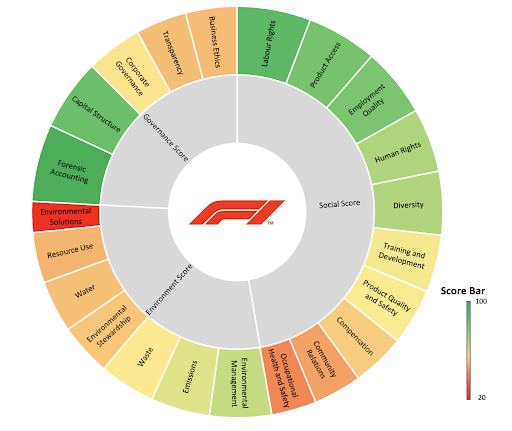The world’s fastest cars, Jedi-like driving skillset, and champagne showers – welcome to the world of Formula One (F1). The prestigious global championship between 10 teams and 20 drivers competing for the fastest man on the planet by racing state-of-art engineering vehicles. Since Netflix’s popular F1 show Drive to Survive, the motorsport championship has been enjoying yet again unprecedented popularity. But with the collective focus on the rising emissions, shouldn’t we just stop driving to survive?
Is Formula 1 sustainable?
In 2019, F1 published its first sustainability strategy and committed to net zero by 2030 – an ambitious commitment from a sport that generates a significant carbon footprint. The report stated that F1 produces approximately 256,000 tonnes of CO2 each year, with 73% of the emissions being generated by the logistics of moving the race set-ups across the world 23 times each year. The report states that the total emission number is a combined figure for Scope 1, 2, and 3. The number is steep, compared to the NBA’s 31,842 and NHL’s 1,430 tonnes of CO2. Interestingly, only 0.7% of F1 emissions come directly from cars, which fades in comparison to the emissions generated from operations.

There are some in F1 that have been promoting sustainability long before 2019. The seven-time world champion, Sir Lewis Hamilton, spent the last decade raising awareness across various sustainability topics, from pushing F1 to be more eco-friendly, and addressing diversity barriers, to promoting eco-friendly food and nutrition. His work is incredibly important as he is a role model for the F1 fanbase. He demonstrates that you can be the best driver in the world while being a vegan and environmental activist. But can F1 match Lewis’ enthusiasm for sustainability? Let’s look at the numbers.
RELATED ARTICLES: Progress in a Static Environment: F1 Teams Take Sustainability Into Their Own Hands | Formula 1 Releases Its 2023 Calendar and Forgets the NetZero Pledge | Is Formula 1 Pushing the Planet to Its Finish Line? |
ESG Data
The parent company behind F1 is the US entertainment giant Liberty Media. It acquired the motorsport group in 2017 for £3.4bn. The company has also a stake in a US baseball team and a satellite radio company. In terms of ESG scores (sector-based assessment), Liberty Media ranks in the impressive pole position of the top 96th percentile amongst the Consumer Services*. Looking at the sub-features, the company scores well on labor-related metrics. Unfortunately, it sits in the bottom 2% on the Environmental Solutions metrics, concerned with environmental products and renewable energy.
Interestingly, F1 vehicles run on the most efficient hybrid power unit. Nevertheless, even if F1 removed all car-related emissions, it would still have 99.3% of its emissions to deal with. F1’s report stated its emissions are combined 1-3 metrics. Its parent group Liberty Media officially discloses only Scope 1 and 2. Given the emission intensity of the races rather than the cars, a detailed report on Scope 3 emissions would be useful to monitor the breakdown of emission sources.

What’s next?
As F1 races to net zero, it must rethink its entire business model from the ground, balancing revenues with sustainability. There seems to be a lot of focus on the cars themselves. However, the first pitstop for emissions reductions must be operations. F1 ships tons of cars, and equipment around the globe every two weeks. The following suggestions could be a way to start:
- Calendar coordination: The teams compete in Miami in May, then in Europe, and Asia, only to return to the US for the Texas race in October. The F1 stated that is already looking into dividing the races into regional rounds to reduce the travel distance.
- Travel & paddock activities: During Covid limited attendance restrictions, F1 teams used virtual garages monitoring the race online rather than having to fly everyone across the globe. This was both a sustainability and cost-saving exercise, could it be the new norm?
- Night races: Do we really need night-time races, in hot countries that require significant energy to power the racetracks?

On the vehicles themselves, F1 teams are at the forefront of technological progress by having the best engineers in the world. Indeed, some of F1’s inventions have already trickled down to consumer vehicles and benefited the wider automotive industry. For example, safety developments, energy recovery systems, navigation, or composite materials. These are inventions from F1 that might be found in cars that you drive daily. Considering that transport is responsible for 25% of global emissions and with over 1 billion vehicles on the road, F1 has the potential to move the needle towards low-carbon societies.
Editor’s Note: The opinions expressed here by the authors are their own, not those of Impakter.com — In the Featured Photo: The start of the last F1 race of the season. Featured Photo Credit: Unsplash.










